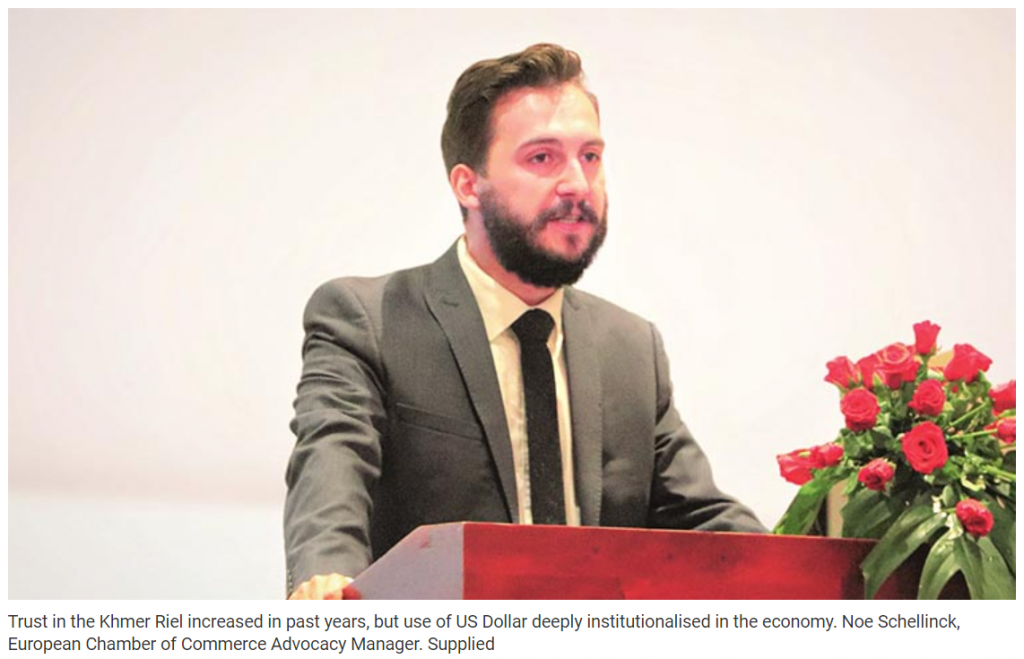De-dollarisation: Views from Asia, US and Europe
De-dollarisation is not a bad thing as it is a re-balancing of the fiscal and monetary policy tools. It is certainly not a complete displacement and substitution of the US dollar in favour of the Khmer Riel in trade and investment, which some observers and analysts seem to mischievously suggest… In fact, promoting greater use of the Khmer riel will give greater monetary policy tools to the Cambodian authorities
Any reduction in the use of the dollar needs to be handled carefully, according to foreign chambers of commerce in Cambodia. They say the central bank is unlikely to fully phase out the US currency and any sudden moves to end reliance on the dollar would be bad for business.
“Trust in the Khmer Riel for sure has increased in the past years, but the use of US Dollar is deeply institutionalised in the economy. This is not any different for European companies, although in certain provinces we, of course, do note a higher use of Khmer Riel compared to US dollar,” said European Chamber of Commerce Advocacy Manager Noe Schellinck. “To a certain extent, the dollarisation now can be ascribed to the success of the Cambodian economy, with a great influx of Foreign Direct Investment, compared to the historic context of when the dollarisation came about.”
Indonesian Chamber of Commerce President Dalton Wong said he expects to see a reduction in the use of the dollar, rather than a completely riel-based economy. “De-dollarisation is not a bad thing as it is a re-balancing of the fiscal and monetary policy tools. It is certainly not a complete displacement and substitution of the US dollar in favour of the Khmer Riel in trade and investment, which some observers and analysts seem to mischievously suggest, which is not so helpful. In fact, promoting greater use of the Khmer riel will give greater monetary policy tools to the Cambodian authorities.”

The National Bank of Cambodia’s mandate is to use the instruments including monetary policy tools and macroprudential measures to maintain price stability and ultimately to mitigate risks including unforeseen shocks to the real and banking sectors. Generally, if the central bank could fully implement the instruments, the risks should be controllable and less severe.
IndoCham’s Wong said Indonesian investors, companies and traders want forex stability and he expects little market turbulence if the reduction in dollar use does not proceed too quickly.
“A secure investment environment and mitigated exchange risks are what they will continue to look for,” he said. “My personal opinion is that there is unlikely to be much of an effect on bilateral trade and investment between Cambodia and Indonesia so long as the de-dollarisation exercise continues to be gradual and at a manageable pace.”
Wong, who is also Executive Chairman at Phnom Penh-based logistics firm SpeedWind Distributions, said increased use of the riel will benefit Cambodian businesses differently, depending on their size.
“De-dollarisation will help ensure and improve the income stability of local small micro and SMEs such as the stall-holders and street vendors,” he said. “At least at the local GDP level, the costs of products and services, and consumer prices will be more stable without the dependency or knock-on effect of a fluctuating exchange rate. However, the impact on a medium to larger enterprise could be rather significant if the de-dollarisation were to happen too abruptly.”
EuroCham’s Schellinck said “Positive actions to promote the Khmer riel through a soft transition process with sufficient flanking measures is a welcoming approach while the launching of digital payments, the like of Bakong app, is less likely to have such effect on confidence. The public cost of the unofficial dollarisation, such as the loss of seigniorage for the government, should be weighed against the broad benefits it brings, on the basis of economic prosperity in the short run. But, in long run and especially in bad time, the cost may be overweight the benefits. We stand ready to support the government in this difficult policy debate.”

Cambodia has benefited from dollarisation, according to American Chamber of Commerce President, Anthony Galliano.
“The Khmer Riel has been extraordinarily stable for two decades, barely fluctuating more than 5 percent either way, even during the financial crisis. Comparatively, since 1997 the Indonesian Rupiah has moved from 2,500 to the dollar, to as low as 15,800, and is now standing at 14,500, devaluing fivefold. In the same period, the Malaysian Ringgit moved from 2.5 to the dollar to 4.2 and now stands at 4.19.
“The Kingdom has enjoyed low inflation, with the exception of the financial crisis in 2008 to 2009. Inflation has been moderate to very low, especially since 2015. Other key economic metrics are firmly solid over the last 2 decades, with GDP worth $27 billion in 2019 from just $3.65 billion in 2000. GDP per capita has tripled in the same period. International trade has grown sixfold in the last fifteen years, now around $36 billion, trade underpinned by a currency that is more widely accepted, stronger, and more internationally recognized. FDI has exploded the last two decades, dollarisation a positive consideration given limited minimal currency fluctuation and providing an income stream in a stable currency, mitigating investment risk. Finally, Cambodia has a history of strong inward flow of dollars related to garments sector exports, tourism receipts, foreign direct investment, and aid.”
De-dollarisation is a challenge that is being executed at the right pace, according to Galliano. Now Cambodians have greater confidence in holding the local currency, he said one of the biggest challenges will be gaining international market acceptance and building global confidence in the riel. De-dollarisation and promoting the use of local currency are still important for long-term economic development.
Source: https://www.khmertimeskh.com/501048440/de-dollarisation-views-from-asia-us-and-europe-2/


 English
English




